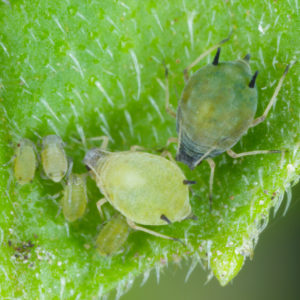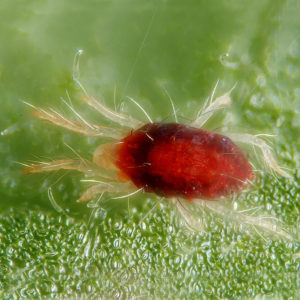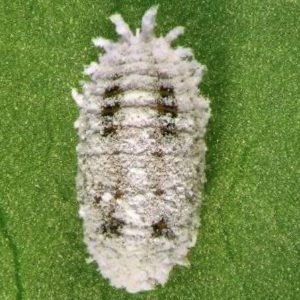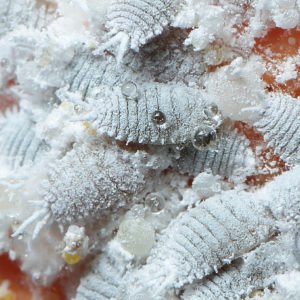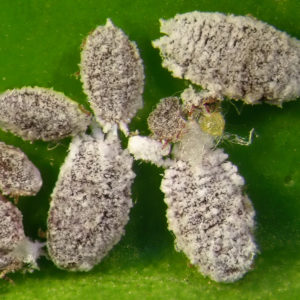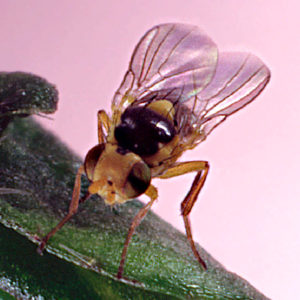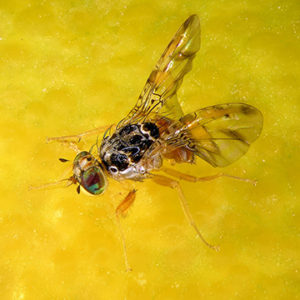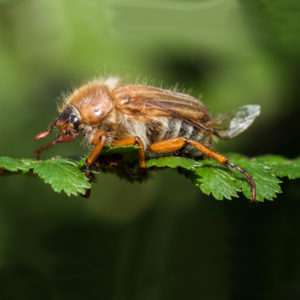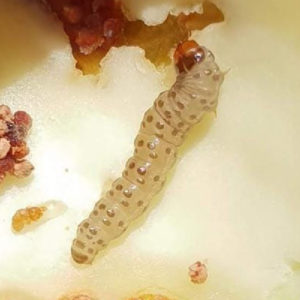There are many species of Aphids (peach potato aphid, cotton aphid, potato aphid, cannabis aphid, rice root aphid, foxglove aphid), while some are host specific (monophagous), others feed on many plant species (polyphagus).
Cannabis aphid
The cannabis aphid (Phorodon cannabis) is pale yellow and later turn light green or pink with darker green stripes running the length of the body.
Cotton aphid
The cotton aphid (Aphis gossypii) is found on more than 700 plant species.
Foxglove aphid
The foxglove aphid (Aulacorthum solani) is also known as the glasshouse-potato aphid; yellow to pale green, it is capable of infesting a wide variety of ornamental and vegetable plants.
Green peach aphid
The green peach aphid (Myzus persicae) can be yellowish-green, red, or brown in color because of morphological differences influenced primarily by the host plants, nutrition and temperature.
Rice root aphid
Rice root aphids (Rhopalosiphum rufiabdominalis) also known as the red rice root aphid, prefer soil and media surroundings, making it difficult to detect. They can appear dark green to brown with yellow or red tinges and like most aphids, may be winged or wingless. The winged rice root aphid will emerge to colonize new plants. Female rice root aphids give live birth to genetically identical daughter offspring that mature quickly. Nymphs and adults feed on all plant development stages.
Spider mites
There are many species of spider mites (around 1,200 species) all belonging to the family Tetranychidae. They generally prefer living in the undersides of leaves, where they spin protective silk webs which are also used as a means to protect their colonies as well as to travel from plant to plant. Spider mites can be difficult to spot but if unchecked, later move to the upper leaves. Spider mites vary in color, thus scouting and identification are key.
Broad mites
The broad mite (Polyphagotarsonemus latus), is a small species of mite found on many species of plants, including important agricultural crops such as grapes, cannabis, sweet pepper, chili peppers, eggplant, cucumber, ornamentals and others. The mite’s oval-shaped eggs are laid on the underside of the leaf or on fruit surfaces. The mites prefer areas of high humidity and low temperature and are a major pest in greenhouses.
Citrus red mite
Adult Citrus red mites (Panonychus citri) are dark red, bordering on purple and their eggs are also dark red. The mites disperse by holding on to a silken thread they produce, and floating on air streams. The citrus red mite is most often associated with citrus but may infest pears, almond, roses and other broad-leaved ornamentals.
Cyclamen mite
Cyclamen mite (Phytonemus pallidus) are tiny mites (less than 0.5mm long) that feed on plant sap by penetrating the plant tissue with its piercing-sucking mouth parts. The mites are mostly found on the underside of leaves, within the flower buds, growing tips and young folded leaves, away from direct sunlight.
European red mite
The European red mite (Panonychus ulmi), also known as the fruit tree red mite attacks fruit trees but can also be a problem in grape vines, ornamentals and roses.
Carmine spider mite
Red spider mite usually favor the underside of leaves and can cause the leaves to curl downwards and often, the leaves turn yellow on the upper side (of the leaves), directly opposite the feeding area.These mites can also be found on the fruit. Fine strands of webbing may be noted in infested areas. Red spider mite can cause russeting or browning of the fruit (similar to rust mite damage), which, if severe, can result in economic loss at harvest time. If the infestation is left untreated, red spider mite can cause defoliation.
Russet mite
There are many species of russet mites: the tomato russet mite (Aculops lycopersici), the citrus russet mite (Phyllocoptruta oleivora), the hemp russet mite (Aculops cannibicola) and many others. Adults and nymphs may appear white, tan, pink or yellow and are almost invisible to the naked eye. Russet mites do not produce the webbing, thus may go unnoticed until there is a build-up of a large population as well as visible damage.
Two-spotted spider mite
Two-spotted spider mite (Tetranychus urticae) is oval and has two dark spots on either side of the body.
Mealybugs
Mealybug is a pest which can have a considerable negative economic impact on a wide range of ornamental and agricultural crops.
Citrus mealybug
The citrus mealybug (Planococcus citri) can be recognized by a slightly darker, longitudinal, dorso-median stripe and it’s orange-brown color with medium length wax filaments at the body margins. The adult female lays amber-yellow eggs in a fluffy posterior ovisac.
Cotton mealybug
The cotton mealybug (Phenacoccus solenopsis) has two broken grey sub-median longitudinal stripes and very short lateral wax filaments.
Delottococcus mealybug
The delottococcus mealybug is a species of mealybug that causes deformation in citrus fruit. They can have a considerable negative economic impact on a wide range of crops and ornamentals.
Grape mealybug
The grape mealybug (Pseudococcus maritimus) is brown to pink in color with a thin mealy wax covering, sometimes with faint, wide dorso-medial line and a pair of posterior wax filaments that are unusually straight. It can have a considerable negative economic impact on a wide range of crops and ornamentals.
Karoo thorn mealybug
The spherical mealybug, also known as the Karoo thorn mealybug, has five to six pairs of short lateral filaments, becoming steadily longer posteriorly, the caudal pair is slightly longer than the antennae. This mealybug can have a considerable negative economic impact on a wide range of crops such as citrus coffee, mango, cotton, soybean, avocado and sweet thorn tree.
Longtailed mealybug
The longtailed mealybug (Pseudococcus longispinus) is easily recognizable by its broad dorso-medial line and 4 very long posterior tails as well as the long lateral wax filaments. This particular mealybug gives birth to live nymphs and does not produce egg masses.
Obscure mealybug
The obscure mealybug (Pseudococus viburni) has two extra-long, thin posterior wax filaments and their honey dew droplets are yellow to orange. It can have a considerable negative economic impact on apples and pears.
Oleander mealybug
The Oleander mealybug (Paracoccus burnerae) is elongated with visible body segmentation and can have a considerable negative economic impact on citrus.
Citrophilus mealybug
This mealybug, also known as the scarlet mealybug, has pronounced wax exudation on the median line which gives it a slight humped back appearance and their honeydew droplets are wine-red. It can have a considerable negative economic impact on apples and pears. DAMAGE A high population of mealybugs can lead to: fruit drop, fruit deformation […]
Vine mealybug
The vine mealybug can be identified by a dark thin dorso-medial line of denuded wax; it can be found on roots as well as above ground. DAMAGE A high population of mealybugs can lead to: fruit drop, fruit deformation and development of discolored welts on the rind of the fruit. Mealybug secrete copious quantities of […]
Thrips
There are many species of thrips, approximately 6,000 species have been described by entomologists.
Chilli Thrips
In warm climates chilli thrips may breed throughout the year, while in cooler climates there is some evidence that it might overwinter in plant debris and become active again in spring.
Onion thrips
Onion thrips (Thrips tabaci) is a worldwide pest with a wide range of host plants and is particularly damaging vegetables and ornamental plants.
Tobacco thrips
Tobacco thrips (Frankliniella fusca) is a worldwide pest with a wide range of host plants. The tobacco thrips is a small insect with a narrow body; females are usually brown or black and the males are yellow, having eight segmented antennae. Some are winged (macropterous) and other aren’t (brachypterous).
Western flower thrips
The western Flower Thrips (Frankliniella occidentalis) is a worldwide pest with a wide range of host plants. A year-round invasive pest, they are less destructive during wet weather. The western flower thrips is a small insect with a narrow body (up to 1.2 mm in length) and yellowish in color.
Leaf miner
There are numerous species of leaf miners: the American serpentine leaf miner, the tomato leaf miner, the pea leaf miner as well as insects in which the larval stage lives in and nourishes itself from the plants leaf tissue.
Chrysanthemum leaf miner
Adults Chrysanthemum leaf miners (Chromatomyia syngenesiae) are small, black to gray flies with yellow markings. The females puncture leaves to feed on plant sap and lay eggs within the leaf tissues. The larval stage lives in and nourishes itself from the plants leaf tissue.
Tuta Absoluta
Tuta absoluta, also known as the tomato leaf miner, tomato pinworm and South American tomato moth, is a major pest of field and greenhouse-grown tomatoes. Adult moths are grey-brown, while newly hatched caterpillars are yellowish and small.
Mediterranean fruit fly
The Mediterranean fruit fly (Ceratitis capitata), also known as the Medfly, is among the most economically important fruit fly species because of its ability to survive in cooler climates and to infest hundreds of tropical fruits and vegetables, causing severe degradation and economic loss.
Whiteflies
Whiteflies are small sap-sucking insects that typically feed on the undersides of plant leaves and can inflict direct and indirect damage to a wide variety of crops and ornamentals.
Greenhouse whitefly (GHW)
The greenhouse whitefly (Trialeurodes vaporariorum), sometimes referred to as the glasshouse whitefly, prefer to lay their eggs on the undersides of leaves.
Sweet-potato whitefly (SPW)
The sweet-potato whitefly (Bemisia tabaci) is sometimes referred to as the silverleaf whitefly. Outbreaks of sweet potato whitefly occur worldwide, resulting in yield loss and economic injury in a wide array of crops.
Black vine weevil
The black vine weevil (Otiorhynchus sulcatus), also known as the taxus weevil or cyclamen grub, is matte black with fused wing covers
Red palm weevil
The Red Palm Weevil, also known as palm weevil, Asian palm weevil or Sago Palm Weevil, is a large weevil and widely considered to be the most damaging insect pest of palm trees in the world.
Strawberry root weevil
The Strawberry root weevil (Otiorhynchus ovatus) gets its name from their preference for strawberry plants yet they are also known to feed on raspberry, rhododendron, grape and peppermint.
European chafer beetle
The European chafer beetle (Amphimallon majale – previously Rhizotrogus majalis) is light tan-brown in color while their C-shaped larvae, are large, whitish with a light brown colored head and six jointed legs.
Japanese beetle
The Japanese beetle (Popillia japonica) is among the most damaging scarab beetles that infest turfgrasses in North America, Canada and Europe.
Macadamia nut borer
The Macadamia nut borer (Thaumatotibia batrachopa) lays its eggs singly on young fruit measuring around 10mm in diameter. Females can lay between 170-300 eggs in their lifetime. On hatching, larvae bore through the skin and into the fruit in search of the seed.
White Grubs
White grubs are the larval or grub stage of several species of weevils and chafers beetles.
Pyriform scale
Pyriform scale (Protopulvinaria pyriformis) also known as heart-shaped scale, is a species of soft scale insect and a pest of avocado and ornamentals. The pear-shaped pyriform scale adult is yellowish-brown to barker brown with a characteristic white fringe.
California red scale
The California red scale (Aonidiella aurantia) gets its name from the reddish-brown scale cover it produces for protection.
Oriental yellow scale
Oriental yellow scale (Aonidiella orientalis) gets it’s name from the color which is almost white pale brown or yellow. The Oriental yellow scale attaches itself to a host plant, loses its legs and remains stationary, covered by a scale-like shield.
Oleander scale
The oleander scale (Aspidiotus nerii) also known as ivy scale is a Hemipteran sap sucking insect, that attaches itself to a host plant and remains stationary covered by a scale-like shield. Males and females are visually dimorphic during development; females have a round scale with an off-centered apex covering them.
Codling moth
The codling moth (Cydia pomonella) is a member of the Lepidopteran family Tortricidae. Not large, they are distinguished from other moths by the golden patterns on their fore-wings: brown spots enclosed in gold, coppery bands. The codling moth young larvae are white with black heads while mature larvae are pinkish white with brown heads. The preferred host plants are apple and pear trees.
False codling moth (FCM)
The False Codling Moth (FCM) adult has patterned wings with a variation of colors (grey, brown, black and dark orange) and lays its eggs on the surface of the fruit. The FCM is nocturnal and is seldom seen in the orchard.
Fungus gnats
Fungus gnats (Sciarids), also called dark-winged fungus gnats, are small, dark, delicate-looking flies that infest soil, potting mixes, container media and sources of organic decomposition.. Adult fungus gnats have light gray to clear wings and slender legs with segmented antennae that are longer than their head. Females lay tiny eggs in moist organic debris or potting soil.
Shore fly
Shore flies (Ephydridae) are minute flies ranging from black to gray in color, that prefer moist environments. Adults and larvae feed on algae and decaying organic matter in planting substrate.


